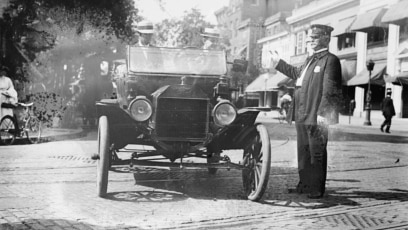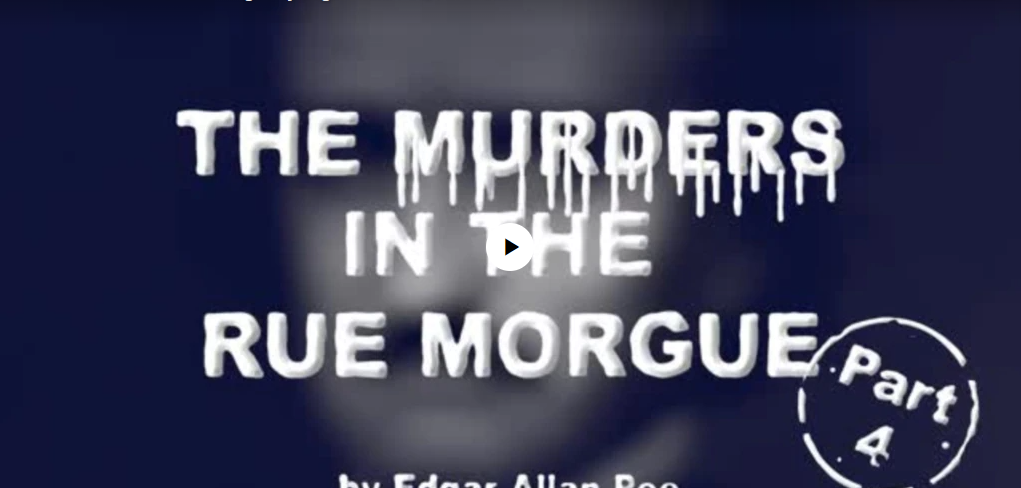We present the fourth of five parts of the short story “The Murders in the Rue Morgue,” by Edgar Allen Poe. The story was originally adapted and recorded by VOA Learning English.
Murder had come to the old house on the street called Rue Morgue! Murder had come and gone and left behind the dead bodies of an old woman and her daughter.
It was a perplexing crime scene. The damage to the daughter’s body suggested a killer of superhuman strength. The knife that had killed the old woman, almost separating head from body, was in the room. But the old woman’s body was outside, behind the house. The door and windows to the house all firmly closed, locked on the inside. Voices had been heard. One voice was speaking in French; the other voice had not spoken even one word that anyone could understand. And yet, there was no one in the room when police arrived moments after the attack.
My friend Dupin was now explaining to me what he had learned when we visited the scene of the crime.
“I knew that what seemed impossible must be proved possible. The killer, and I believe there was just one, escaped through one of these windows. After the murderer had left he could have closed the window from the outside; but he could not have fastened the nail. Yet anyone could see the nails which held the windows tightly closed. This was the fact that stopped the police. How could the murderer put the nail back in its place?”
“That’s the problem, Dupin! Perhaps — perhaps if you pulled out the nail…”
“Yes! That is just what I thought. Two things seemed clear: first, there had to be something wrong with the idea that the nails were holding the windows closed. Second, if it was not the nails which were holding the windows closed, then something else was holding them closed, something hard to see, something hidden. So, I checked the first window again. I removed the nail. Then I again tried to raise the window. It was still firmly closed. There had to be a hidden lock, I thought, inside the window. I searched the window frame. Indeed, I found a button which, when I pressed it, opened an inner lock. I raised the window with ease.
“Now I knew that the killer could close the window from outside and the window would lock itself. But there was still the nail. So, I returned the nail, pressed the button and again tried to raise the window. The nail held the window closed!”
“Then…the window could not have been the means of escape!”
“That window, no. The killer did not escape through it. But I went again to the other window. The nail there looked the same as the one I had just seen. I moved the bed so that I could look closely. Yes. There was a button here, too. I was so sure I was right that without touching the nail I pressed the button and tried to raise the window. And guess what happened?”
I knew the answer but I let Dupin have the satisfaction of reporting. The window went up, he told me.
“As the window went up, it carried with it the top part of the nail, the head. When I closed the window, the head of the nail was again in its place. It looked just as it had looked before. The nail was broken but looked whole. And, what is impossible is proved otherwise.”
“So the murderer went out that window. Did he arrive in the room by that path as well?”
Dupin answered, although it seemed he was speaking more to himself than me.
“It was a hot summer night. Would the victim have opened the window to get some fresh night air? Most likely.”
“So, the killer found it open and entered, I said.” Dupin nodded.
“And, as he came, the window locked when it closed. The lock held the window closed not the nail, as it appeared to investigators. Again that which seemed impossible was actually possible.”
Dupin’s eyes were shining with the satisfaction discovery brings. He was analyzing evidence and his unusual reasoning ability had found a great purpose. I suddenly understood:This is why going to the house on the Rue Morgue seemed “pleasing” to Dupin. The use of his sharp mental abilities made him happy.
And, I had more work to provide that great brain.
“Dupin — the windows are on the fourth floor, far above the ground. Even an open window…”
Dupin shook his head up and down slowly.
“Yes…yes. That is an interesting question: how did the murderer go from the window down to the ground and vice-versa? But I had looked around carefully outside you recall. And I knew a way. And the answer to this question told me still more about the identity of the killer. Do you remember, friend, the lightning rod attached to the house?”
I paused. “Yyy…yes. A metal pole, and quite narrow. It protects the building from lightning strikes. But it is so tall and thin.”
“True. It would take great strength and agility to get up the pole. Some kinds of animals might climb it easily, yes? But surely not every man could. In fact, maybe very few men. Those of very special strength and special training.
“This helped create a better picture of the murderer. But still not sharp enough to recognize. I still had the question: who?
“We know the killer climbed the pole, entered the room through the window, murdered and destroyed all order in the room. He managed to push one body up the chimney. He threw the other, almost headless, out the window. Then he left the way he came. We can answer the how of the crime. But who? Such unspeakable viciousness…what human could do this to another?”
Dupin continued, trancelike again, seeming to speak to himself as much as to me.
“Perhaps we can come closer to answering the question of who by exploring the question of why.”
“But Dupin, the police said the motive must have been robbery.”
“But my friend, what was taken? The police said they could not answer the question. They said they did not know what the women had. Maybe clothes and jewelry, the investigators proposed. But neighbors described the women as nearly hermits, rarely if ever, leaving the house. Of what use would fine clothes and costly jewelry be to them?”
Dupin’s eyes were glistening, his brows pointing sharply down, as he circled me, thinking aloud.
“But, what is more telling than what the killer might have taken is what he left behind…conveniently in bags in the center of the room…”
“Of course, the money. You are right, Dupin. It makes no sense. All the money delivered from the bank to the old woman. Right there on the floor. Why would the attacker have passed on the riches? A thief certainly would not.”
“So, I want you to forget the investigators’ claim that the killer acted out of a desire for money. They thought this only because they knew the money had arrived just three days before the killings. But that was just chance. If gold was the reason for the murders, the killer must have been quite a fool to forget and leave it there.
“No. I think that there was no reason for these killings…except, perhaps, fear. The wild nature of the attack leads me to a motive of fear.”
“Hmm, an interesting theory, Dupin. Fear can bring out the crazed beast in a person…”
“In any living thing. Now let us look at the murders themselves. A girl is killed by powerful hands around her neck, then the body is placed in the opening over the fireplace, head down. Unusual, even by the standards of the most terrible criminals. Think, also, of the great strength needed to put the body where it was found. It took several men to pull it out! Also the hair pulled from the head of the old woman. You saw it on the floor yourself, and you saw the blood and skin still attached. It takes great force to pull out even twenty or thirty hairs at a time. But this was hair AND scalp! And there was no reason to almost take off the woman’s head just to kill her.”
“It is extremely odd, I agree. Especially since there is no evidence that the killer knew the victims. No one could hate a stranger enough to carry out such torture.”
Dupin’s eyes narrowed.
“Exactly.”
____________________________________
For Teachers
Download activities to help you understand this story here.
_________________________________
Quiz: The Murders in the Rue Morgue, Part Four

Start the Quiz to find out
Now it’s your turn to use the words in this story. What kinds questions do you ask yourself and others when trying to solve difficult problem? What are things you think of that no one else usually does? Let us know in the comments section or on WWW.VOA-STORY.COM.
_____________________________________________________________
Words in This Story
superhuman – adj. greater than normal human power, size or ability
button – n. a small, usually round piece of plastic, glass, metal, etc., that is sewn to a piece of clothing and used for fastening one part of the clothing to another part
lightning rod – n. a metal pole often attached to homes or buildings used for attracting lightning
pole – n. a long, straight piece of wood, metal or some other material, that is often placed in the ground so that it stands straight up
trancelike – adj. to be (or seem to be) in a state where you are not aware of what is happening around you because you are thinking of something else
hermit(s) – n. a person who lives in a simple way apart from others especially for religious reasons
glistening – gerund. shining with light, as if reflected off a wet surface
brow(s) – n. the line of hair that grows over your eye
thief – n. a person who steals something
scalp – n. the skin on the top of your head where hair grows
